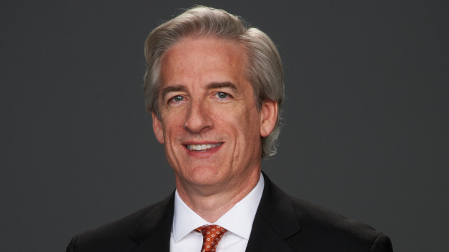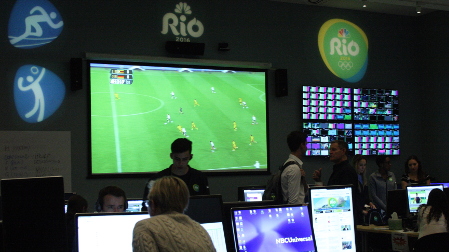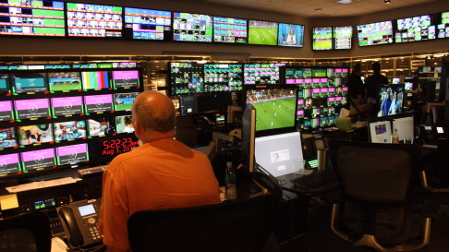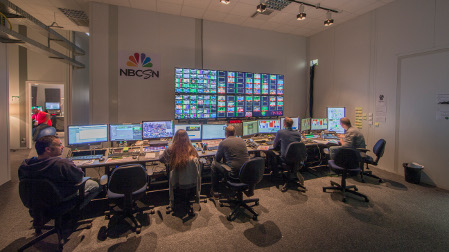NBC & the Olympics: Erasing the Barrier of Distance, Thinking Toward 2020
The Summer Olympics broadcast from Rio de Janeiro produced an unprecedented volume of content. The NBC Olympics team built on everything that was successful from prior Games, and added more hours, more live streaming, more circuits, significantly more social media, more mobile, some new virtual, more high speed, new VR, new 4K HDR, and much more at home production and activity. TV Technology chatted with David Mazza, CTO & SVP, NBC Sports Group & Olympics, about the big effort from Rio, and preparing for both 2018 Winter Games in PyeongChang, South Korea, and the big 2020 Summer Olympics from Tokyo.
TV TECHNOLOGY: What was the biggest surprise from Rio, both from a production/engineering standpoint and in general?

Dave Mazza
DM: The high water mark, the salt, the sand and the wind were all underestimated. Many of the broadcasters like us had studios at Copacabana Beach, and it was a real challenge there with the level of surf. We had times during the set-up when portions of our Copa Beach set were nearly under water. And there was barely a day when the wind wasn’t whipping around sand and salt, which made it hard to get and keep equipment working at times.
Also, it was not just the sheer tonnage of work and programming in Rio, which was greater than it’s ever been before. It was also that the number of distinct things going on was off the charts.
The fact that everybody knuckled under and focused on their piece—even with all sorts of potential distractions going on around them—that was not a surprise, but was really impressive to see.
There were times when we had 13 control rooms active between North and South America. That required a tremendous effort by a lot of really talented people to keep it all going.
Get the TV Tech Newsletter
The professional video industry's #1 source for news, trends and product and tech information. Sign up below.
On the softer side, but not really a surprise, I’d say how beautiful the city was, and how warm and friendly the people were. Although this was probably our most challenging Games, it was a great experience because of the people.
TVT: Now you face a short turnaround before the 2018 Winter Games from PyeongChang, South Korea. Are you changing things up a bit or trying to limit changes?
DM: We actually have a team there this week, setting the groundwork for some of the higher-level logistical planning and production planning. Myself and the technical team will probably go in a few months for the world broadcaster meeting.
We’ll have to make some upgrades simply because of aging equipment. However, as you know on the short turnarounds between a Summer Games and a Winter, we’re trying not to change much, because there isn’t time.
We really only have the balance of this year to get a lock on the production needs, and the design, and the ordering of any new equipment. By the first week in January, we need to start our pre-fab efforts. So, there’s not a lot of time to mess around.

We are evaluating some of our gear that is aging, and trying to determine if it should be replaced or if it can get through one more Games. If it does need to be replaced, we need to consider the migration to an IP infrastructure as we don’t think there is any doubt that will be our next infrastructure change. We now have the beginnings of an IP infrastructure in Stamford, Conn. In addition to our Coax router, the IP router is working well and running one of our control rooms. We’re testing, learning and waiting for that to fully stabilize to the degree that it would be ready for primetime and an Olympics. And we need more time than we have for the full changeover. So, the likely change to IP will be after Korea.
TVT: What about the HDR trial from Rio, and what might this mean for the Korean Games?
DM: We were very impressed with HDR. I think it definitely needs to be part of the next broadcast standard. We did it at the Opening Ceremony and had some fabulous pictures to show from there.
The big question for all of us as an industry is, how is it going to coexist with SDR and Rec 709. It’s one thing to coexist with 4K SDR , but when HDR is added to the equation it becomes considerably harder to coexist, and we can’t afford to have two productions moving forward.
That’s something we’ll need to figure out once the standards settle down. If we do something (in Korea) it will likely be more of a test deployment. We also need to wait and hear what (Olympics host broadcaster) OBS is doing. They too are trying to figure out what is feasible over the next 17 months.
TVT: Speaking of what is new and feasible and tied to OBS to an extent, what about the VR experience from Rio?
DM: There’s obviously a lot of consumer electronics and consumer interest in VR, so we’re taking it very seriously. Rio was mostly just a pass-through (from OBS). The OBS team did all the work on it, and they learned a lot. We haven’t yet circled back with them to get their feeling on it.

Highlights Factory, NBC Sports Group Production Facility in Stamford, Conn.
For sports, it’s still a technology trying to find the right application. It gives a unique perspective for the venue it is deployed at, but other than allowing the viewer to look at whatever they want…when they want, the viewer still spends a lot of time following the match by looking up at the ‘Virtual Jumbotron,’ displaying the director’s program cut – with the use of all the multiple cameras, angles, long lenses, slo-mo replays, and specialty cameras.
It’s a unique addition, whether you call it a Second-Screen or an alternative for the viewer. But for a large scale event (covering a large playing field), the viewers still seem to gravitate to the director’s cut and the high-end broadcast feed. VR has merit and I think it has legs, but everyone seems to be trying to find its sweet spot.
TVT: What were the best moments of the Games, for you and the team?
DM: Overall, I was proud that everybody shut out all the distractions and got their jobs done. We’ve never had a more ambitious plan than we did in Rio, and it required an extraordinary amount of focus. So perhaps the biggest accomplishment was not watering down those ambitious plans based on possible challenges, and actually having it all come off so well.
There was so much attention before the Games to all the potential challenges in Rio. We all just had to keep our heads down and tune out the distractions because when the Opening Ceremony comes you can’t look back. The Opening Ceremony is going to happen and you have to be ready.
From a purely technical perspective, the best moment or accomplishment was simply that we erased the barrier of long distance. We really could do whatever we needed on either continent without concern about distance, or latency, or picture quality, or proximity. To some degree we have been working on that since Atlanta in 1996, and the fact that we’ve eliminated the barrier of long distance is a big deal.
TVT: Any non-technical favorite moments?
DM: From the competition standpoint, the time I remember most is the Gold Medal football match for Brazil. After their defeat in the World Cup, and knowing so many Brazilians and seeing how excited they were about the possible redemption – that was a really special event.
TVT: I’ve been talking a bit about the Korea transition. What about Tokyo 2020?
DM: You’re so exhausted when you come out of something like Rio, you wonder how the next one could possibly get any more complex. We felt like we left everything on the playing field in Rio. As far as Tokyo goes, it’s a question of how do we repeat the same thing with a little bit of growth. How do we do it better, with less pain and suffering.
In terms of actual planning, we’re very much focused on Korea right now. If we do need to make some changes to aging equipment for Korea, we do need to think a bit about how that equipment will fit in by Japan, however.

Broadcast Operations Center, NBC Sports Group Production Facility in Stamford, Conn.
TVT: What about ‘proofs-of-concept’ or ‘Science Projects’ from Rio. Any takeaway?
DM: We did spend a lot of time on 4K and HDR as we discussed, and that was pretty much a big Science Project.
We had some new remote production going on between venues and the IBC, with Lawo units that move four signals across the LAN along with MADI and data and more. This allowed us to aggregate all the material from a small venue and then move it to the IBC and back. We did this at basketball , and road cycling, the marathon and the triathlon.
We didn’t know we were going to do this, but about two weeks before Opening there was a request from production to basically do some Off Tube voiceovers with one announcer in Rio and one in Stamford. We called this a ‘collaborative off-tube,’ and it actually required quite a bit of innovation to get it to work, but it was fun and it worked really well.
TVT: You’ve been in charge of Olympic broadcast engineering for 20 years now, and been involved in Olympics even longer than that. Reflect on the challenge in 1996 vs 2016.
DM: Atlanta in 1996 was composite analog and composite digital in edit suites. We had the virtual IBC split between Atlanta and 30 Rock in New York, and only 170 hours of produced content on the network. We had every DS3 (line) AT&T had on the east coast busy. Which amounted to thirty-seven 45 Mbps DS3s, with one SD NTSC feed on each one. This equated to about 1600 Mb of bandwidth.
Twenty years later we had 132 HD feeds, and 13 control rooms running, three in Rio and 10 back home. We did roughly 1500 hours of produced programming, along with 7000 hours of streaming.
In Atlanta, the internet was just coming to life, and none of this remote control or IP or WAN infrastructure existed. Anything remote control was done by brute force and we had to cobble that together ourselves. We had just one Cisco router that did the graphics file exchange, but the concept of a file-based workflow didn’t really exist.

Section of Broadcast Operations Center inside NBC Olympics Production Compound within the IBC in Rio de Janeiro.
In Rio we had 225 Cisco routers and switchers, obviously not all used for file-based television, but it’s 225 to 1 in Atlanta. And we had four 10 Gb circuits from Rio, which is something like 40,000 Mbps, versus the 1600Mbps in Atlanta.
In Atlanta, time was spent on things like getting all the separate analog audio and video wires in the right place, timing, equalization, hum and phase. This was mostly hardware-based, and just keeping power on was critical. In Rio time was spent on things like cleaning fibers, software configuration, IP addresses, multicasting, hitless packet merge, and viewer authentication. It was mostly software based, however keeping the power was still a challenge.
It went from keeping analog hardware ‘tweeked’ as we used to say, versus the overwhelming complexity of software and databases.
You still worry about getting the right thing to come out of the program monitor at the right time, but the way we’re doing it is so very different.

